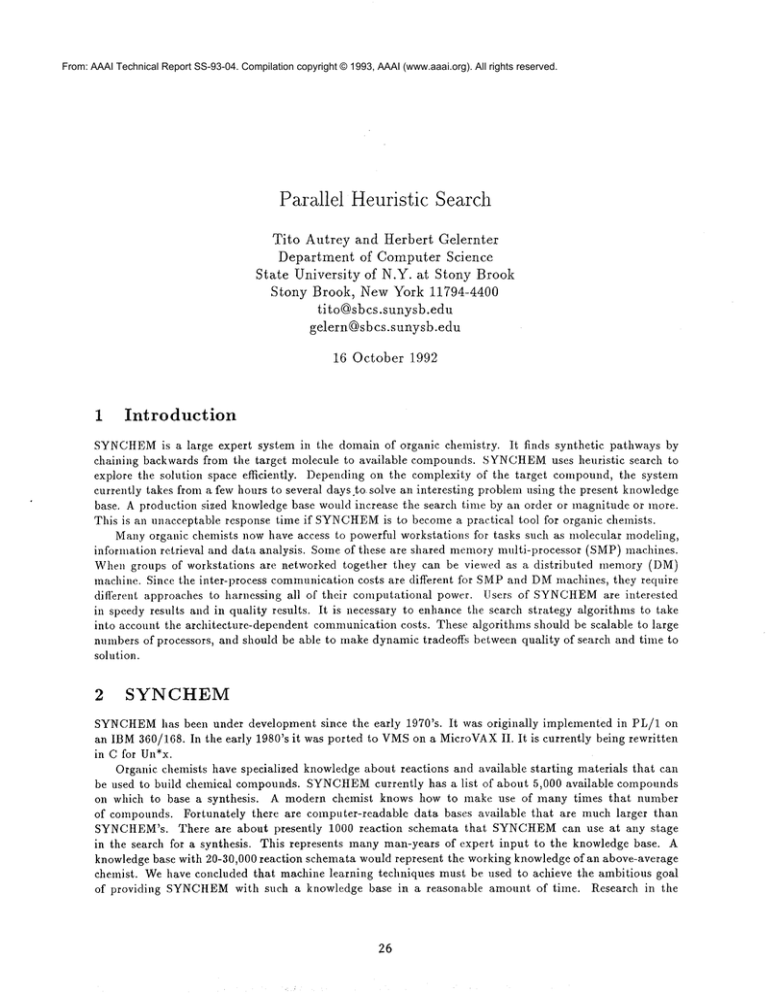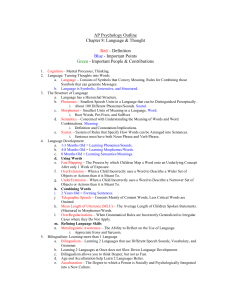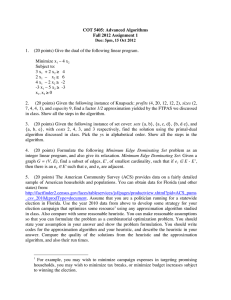
From: AAAI Technical Report SS-93-04. Compilation copyright © 1993, AAAI (www.aaai.org). All rights reserved.
Parallel
Heuristic Search
Tito Autrey and Herbert Gelernter
Department
of Computer Science
State University
of N.Y. at Stony Brook
Stony Brook, New York 11794-4400
tito@sbcs.sunysb.edu
gelern@sbcs.sunysb.edu
16 October
1
1992
Introduction
SYNCHEM
is a large expert system in the domain of organic chemistry. It finds synthetic pathways by
chaining backwards from the target molecule to available compounds. SYNCHEM
uses heuristic search to
explore the solution space efficiently.
Depending on the complexity of the target compound, the system
currently takes from a few hours to several days.to solve an interesting problem using the present knowledge
base. A production sized knowledge base would increase the search time by an order or magnitude or more.
This is an unacceptable response time if SYNCHEM
is to becomea practical tool for organic chemists.
Manyorganic chemists now have access to powerful workstations for tasks such as molecular modeling,
information retrieval and data analysis. Someof these are shared memorymulti-processor (SMP) machines.
Whengroups of workstations are networked together they can be viewed as a distributed memory (DM)
machine. Since the inter-process communication costs are different for SMPand DMmachines, they require
different approaches to harnessing all of their computational power. Users of SYNCHEM
are interested
in speedy results and in quality results. It is necessary to enhance the search strategy algorithms to take
into account the architecture-dependent communicationcosts. These algorithms should be scalable to large
numbers of processors, and should be able to make dynamic tradeofi~ between quality of search and time to
solution.
2
SYNCHEM
SYNCHEM
has been under development since the early 1970’s. It was originally implemented in PL/1 on
an IBM360/168. In the early 1980’s it was ported to VMSon a MicroVAX
II. It is currently being rewritten
in C for Un*x.
Organic chemists have specialized knowledge about reactions and available starting materials that can
be used to build chemical compounds. SYNCHEM
currently has a list of about 5,000 available compounds
on which to base a synthesis.
A modern chemist knows how to make use of many times that number
of compounds. Fortunately there are computer-readable data bases available that are much larger than
SYNCHEM’s.There are about presently 1000 reaction schemata that SYNCHEM
can use at any stage
in the search for a synthesis. This represents many man-years of expert input to the knowledge base. A
knowledge base with 20-30,000 reaction schemata would represent the working knowledgeof an above-average
chemist. Wehave concluded that machine learning techniques must be used to achieve the ambitious goal
of providing SYNCHEM
with such a knowledge base in a reasonable amount of time. Research in the
26
inductive and deductive extraction of reaction schemata from large reaction databases is being pursued in
the SYNCHEM
project.
2.1
Details
of Search
The search space is represented by an AND-OR
tree called the Problem Solving Tree (PST). The reaction
schemata are represented as graph rewriting rules with pre- and post-transformation tests to constrain and
mediate their application.
An AND-nodeis a chemical compound. Each OR-node represents the results
of an application of a single reaction schema to a compoundat a specific reaction site. A compoundcan
have multiple sites where a reaction may be applied. Each such site may be represented by a different
OR-node, but in certain cases an OR-noderepresents more the application at more than one site. The set of
OR-nodechildren of an AND-node
represents the application of all possible reactions at all possible reaction
sites. Expansion is defined as the execution of a single graph transformation operator on an AND-nodeto
generate part of its set of OR-nodes. Each OR-node has as children a set of precursor compoundswhose
size is determined by the transforms application to a specific molecule. An OR-nodewith its set of child
AND-nodesis called a subgoal. The process of generating all possible subgoals for a given AND-nodeis
called a cycle.
The search strategy is responsible for determining which node is to be developed next. If a subgoal’s
component AND-nodesare all marked as solved or available then the subgoal is marked as solved. Each
subgoal has an heuristic valuation as well as a strategy-specific
valuation that are combined. SYNCHEM
chooses the subgoal with the highest strategic value that is not yet solved as the one to develop next. In
order to fairly evaluate a subgoal, the AND-nodewith the lowest value is expanded first. This means that
the hardest componentof the subgoal is the first to have its value more precisely determined.
2.2
Details
of Expansion
The reaction transformation is a graph embedding. Graph embedding is related to the graph isomorphism
problem, which is known to be NP-hard. Pre-transform tests are substantially cheaper to execute than an
expansion; thus they are used before expansion to detect compoundswhere the reaction is knownto fail. The
post-transform tests attempt to determine whether the embedding has produced structurally and mechanistically wdid molecules, and if necessary, to alter the heuristic values in accordance with domainknowledge.
Thus an expansion cycle adds to the PST only those compoundsderived from schemata applications which
are valid. Since organic chemistry is a complexdomain, it is impossible to encode all of it in the knowledge
base. Anyproposed solution must therefore be verified by a domain expert.
Note that it is possible to arrive at the same intermediate compoundthrough different retrosynthetic
paths. In this case the compoundnode is only placed onto the PSTat the point where it was first generated.
All other places where the compoundappears in a pathway simply point to that AND-node.A data structure
called the Symbol Table (ST) keeps track of information associated with individual compounds, including
solved and available status and heuristic valuation.
After each expansion cycle is completed, heuristic values are computedfor all new subgoals. The values
of children subgoals affect the values of their parent AND-nodeswhich in turn affect the values of their
parent subgoals. Because a particular compoundmay appear in more than one place in the PST, the update
procedure requires potentially writing to the whole data structure. Update of a large global data structure
has negative implications for paratlelization.
Search with only local information is muchsimpler, but for
domains as complex as that of synthetic organic chemistry it will not produce results comparable to search
with global information. By this we mean the local approach will take longer to arrive at the same quality
of results as the global npdate approach.
SYNCHEM
checkpoints the in-memory data structures to disk, and this can take quite a bit of time
when the PST and ST get large. While checkpointing is relaxed from once per cycle to once per five or even
twenty-five cycles at later stages of the search, it still takes significant time. The large checkpoint overhead
27
has negative implications for the parallelization of SYNCHEM,
since scaling up the size of the problem is
commonfor parallel applications. Fortunately, as will be shownlater, there is a simple work-around.
There are several search strategies that have been used by SYNCIIEM.One of these, namely Effort
Distribution (ED), has proven to be most general. ED ensures that the search does not focus blindly on
single path. It calculates the amount of resources (CPUtime) expended in expanding each branch in the
tree so far. By applying a search-depth dependent function to each subgoal, it ensures that the heuristically
best subgoals don’t get all the search time, and that some non-best subgoals are expanded as well, which
increases the branching of the tree. The other search strategies, auto-protection, lookahead and strategic
bond selection turn out to be subsumed by SYNCHEM’s
choice of valuation functions. These strategies rely
on computationally expensive domain knowledge to guide the search. ED uses simple resource consumption
analysis and so is computationally cheaper (has lower overhead) than the other listed strategies. It is also
likely to be applicable to other domains.
3
Parallelization
The following is a typical example of all early-middle search cycle of a moderately difficult compound.Note
that early cycles generally have small trees, so the checkpointing and update contributions to the runtime
are not representative. The cost of checkpointing and updating the PST grows as the search progresses.
With the current algorithms it is not uncommonfor the overhead attributable to them to reach 50%by the
500th cycle.
The 100th expansion cycle of podopyhlotoxin, a tricyclic structure, took 745 seconds on a MicroVAX
II;
61.9%for the graph embeddingand post-transform tests; 15.0%for searching through the reaction schemata
and applying the pre-transform tests; 12.1%to copy the program state to disk; 6.1% to update the tree; and
5.0%to select the next node to expand.
The most obvious approach is to take advantage of task-parallelism and do the expansion of a particular
AND-nodein parallel. Each reaction schema could be treated as a distinct task; the pre-transform tests,
graph transformation and post-transform tests for individual schemata are independent of each other. That
accounts for 77%of the program runtime, but by Amdahl’s law it can net at most 4.3 times speedup.
The next choice would be to take advantage of IO/CPUasynehrony and write the in-memory datastructures to disk asynchronously. Because the current algorithm dates back to before virtual memoryhad
become common, it is non-optimal in that the program pages data in and out of memoryon its own. A
simple logging facility which would write out the results of an expansion cycle rather than the whole PST
would allow the tree to be reconstructed by treating the logfile as a re-do log. With large buffers and
asynchronous IO system calls, it should take a small amount of time. This change taken together with
node-level parallelism accounts for 89%of the runtime, which gives at best 9.1 times speedup.
Optimal heuristic search order is a total order on the sequence of AND-nodesthat are expanded. The
expansion order is based on the heuristic values reflecting all the expansions that have occurred earlier in the
order. Each node in the optimal heuristic order is called a choice node since its strategic value would reflect
all the information available at the time of its selection. If an AND-node
is selected whose heuristic values
do not reflect the information available from all choice nodes selected before it, it is called a current-choice
node. If current-choice nodes are expanded then the search order becomesa partial order. Manyconcurrency
models are based on partial orders, so this seems like a good way to model this algorithm. Current-choice
nodes can be chosen for expansion concurrently. Since the operations performed on each compoundare the
same, this is data-parallelism.
The approach with the potentially largest payoff in terms of increased concurrency is to use a partial
order related to optimal heuristic search order and therefore to expand AND-nodesin parallel. But this
has many unexplored implications with respect to quality of search and parallel efficiency. The current
strategy works to make sure that there is some breadth-first character to what would otherwise be a mostly
depth-first search of the solution space. A new strategy is being developed to take into account the inherent
breadth-first nature of expanding nmltiple nodes in parallel. This strategy balances expanding multiple
28
AND-nodeswith expanding a single AND-nodein parallel. The difficulties come from trying to ensure that
the PSTis updated sufficiently frequently that the values used for selection converge towards those found in
a sequential execution.
To take full adwmtageof the heuristic nature of the problem, it is necessary to modify the update and
select algorithms. In a fully parallel SYNCHEM
the PST should ideally be updated after each cycle so that
only choice nodes are selected, but this requires excessive locking overhead. Instead, a queue of nodes to
expand can be maintained with a flag to indicate that the heuristic values in the tree are in the process of
being updated. If the flag is set, then the queue contains current-choice nodes, otherwise they are choice
nodes. If a current-choice compoundis chosen for expansion, all that has happened is that the expansion
has occurred out of optimal heuristic order. The subgoals expanded may in fact be the same, but the order
maybe different. For certain traces of execution, the order of expansion will be the same as the optimal
heuristic order.
Additional intermediate level concurrency can be obtained by parallelizing various parts of the knowledgerelated algorithms and the housekeeping algorithms. The graph embedding algorithm is computationally
expensive, so any speedup here reduces the total runtime significantly. The pre-transform tests are independent of each other, as are the post-transform tests. The extraction of many, but not all, individual
features characterizing molecules can be done concurrently; in decreasing cost order: canonical naming (for
the ST), resonant and aromatic bond determination, ring structure analysis, functional group enumeration
and elemental composition. For most of the algorithms above, a very high quality (low overhead) thread
package is needed to make parallelizing
them worthwhile. Even then only an SMPmachine would provide
worthwhile results. A DMmachine such as an iPSC/860 would require additional effort to take into account
the limited memoryof each processing node. Scheduling this level of task efficiently on such a DMmachine
is difficult.
Frequently the heuristic values of two or more subgoals are close. Whenthis occurs it indicates that
the valuation function is not able to distinguish which of the choices is preferred. In such cases it seems to
make sense to evaluate more current-choice nodes so as to minimize the possibility that too nmcheffort may
be concentrated in the wrong place. This trades off task-parallelism for data-parallelism. In cases where
the heuristic valuation between subgoals differs substantially it makes sense to expand the higher valued
brauch(es) faster. The range of heuristic values is often small relative to the numberof nodes generated.
order to be able to distinguish amongthe larger number of nodes that are produced by a parallel SYNCHEM
it is necessary to modify the valuation functions to produce a larger range with greater frequency. To make
this choice one needs some understanding of the way the predictions derived heuristically differ from those
provided by an oracle. This difference should be used to determine the distribution of search effort between
choice and current-choice nodes in the PST.
3.1
Performance
Evaluation
One question we must consider is that of identifying measures that are be useful for evaluating heuristic
search. Rate of rule execution, quality of search, time to first solution and time to best solution are important
measures. The best solution cannot be known without examining the whole search space, so a workable
definition might be "best result with bounded effort" (in SYNCHEM’s
case, effort is measured in cycles),
or "best of first x solutions". As a measure of the quality of one’s heuristic valuation function, it would be
interesting to note howoften the first solution was identified as the best by a domain expert. Quality of
search should measure howmucheffort was spent non-productively. By definition, with an oracle to provide
the heuristic values, there is no wasted effort. Since there are multiple reaction pathways available, nonproductive time should only be counted for pathways that are inferior, by someloose measure, to the one(s)
that lead(s) to the best solution. Mechanistically different pathways are very desirable, but not at a great
cost in the quality of the search. Someusers maybe interested in time to solution and nothing else. This is
the standard parallel speedup measurement.In heuristic search, where this interesting tradeoff between time
to solution and quality of search exists, the architect of the system will want to measure what the tradeoff
is and howit varies with the controllable parameters of the search. In particular, the search strategy always
29
needs to keep tile parallel efficiency high enoughso that the search can scale to a large numberof processors.
3.2
Rewriting
SYNCtIEMis currently being ported from PL/1 on OpenVMS/VAX
to G on Un*x, SUNos on SPARCin
particular. Manyof the current SYNCtIEM
algorithms are serial in nature, but there are knownparallel
analogs that can be employed to enhance concurrency. Without looking too hard one call identify several
componentsthat can be parallelized with good return on effort invested. The checkpointing facility will be
left out initially. It will be replaced after other non-parallel functionality is demonstrated to be working.
The first interesting stage is achieved when node-expansion parallelization has been implemented.
3.3
Experiments
Progress call be measured by experiments. The simplest of which is to determine whether the C version
reproduces the results of the PL/1 version, at least with respect to solution pathways discovered. Since
the timing will be different (the C version should be more efficient), the actual trees covering the search
space will likely be different. Even so, measuring the C version versus the PL/1 version on a MicroVAX
II will produce useful information. Measuring the MicroVAX
versus the Sun IPX will also produce useful
information about the efficiency of the respective systems for the task. Weanticipate that the SPARC
with
it’s register windowswill be at a relative disadvantage because of some of the highly recursive procedures
within the code. The Sun IPX can be measured against a single processor of a SGI 4D/340 for another
data point. Finally, whenthe parallel code is ready, it can be run on an SGI 4D/340(4 processor machine).
Then, if the C compiler is willing, it will be run on a 7 processor Sequent Symmetry,and if the fnnding is
able, on a 64 processor KSR1. These experiments should give some idea of the improvements that can be
extracted from an intelligent rewrite, the improvementsavailable from faster systems and the improvements
achievable via small scale (medium-scale if the KSR1is available) shared memoryparallelism.
4
Conclusion
Heuristic search is indispensable to tile solution of a large class of AI problems.Parallelizing heuristic search is
clearly desirable and interesting, at least in the presence of global update and selection functions. SYNCIIEM
provides a highly complex domain testbed to examine what is necessary to make parallel heuristic search
efficient. In this case, complex also means that the domainhas the apparent advantage of large granularity
task and data parallelism. This property serves to push the point on the parallel speedup curve where the
marginal return on effort starts to deteriorate to a large value, but does not change the difficulty of the task.
The goal of this research is to develop highly scalable algorithms for parallel heuristic search. These
algorithms should take advantage of the uncertainty in best-node selection and they should balance dynamically the needs for both short tinle to solution and quality of search. The results of the initial effort in a
shared memoryenvironment will help clarify the issues in the more difficult regime of a distributed memory
environment such as a network of workstations.
5
Bibliography
CarDGelg0 N. Carriero and D. Gelernter;
Howto Write Parallel
Programs. Cambridge: MIT Press, 1990.
ChenGel90 C. Chen and H. Gelernter; "TRISTAN:an explanation-based
learning system for organic
chemistry". Methodologies for Intelligent Systems, 5, Z.W. Ras, M. Zemankova, and M.L. Emrich,
eds. NewYork: North Holland, 1990.
ChenGel91 C. Chen and H. Gelernter; "IREF--An interactive theory-driven knowledge refinement tool".
[EEE Proc. Seventh Conf. on A.L Applications. Silver Spring: IEEE Computer Science Press, 1991.
30
GelBhag83 H. Gelernter,
S.S Bhagwat, D.L. Larsen, and G.A. Miller; "Knowledge-base enhancement via
training sequence". In Computers in Chemical Research and Education, S.R. He]ler and R. Potenzone,
eds. Amsterdam: Elsevier Sci. Pub., 1983.
GelMiBer88 H. Gelernter,
G.A. Miller,
D.J. Berndt;
SUN¥ Research Foundation
and SYNCHEMGroup,
User’s
1988.
Guide to MicroSYNCHEM. Stony Brook:
GelMiLar84 H. Gelernter,
G.A. Miller, D.L Larsen, and D.J. Berndt; "Realization
of a large expert
problem-solving
system: SYNCItEM2, a case study". IEEE Proc. First Conf. on A.L Applications.
Silver Spring: IEEE Computer Science Press, 1984.
GelRoChen90 tI. Gelernter,
J. Royce Rose, and Chyouhwa Chen; "Building and refining
a knowledge base
for synthetic organic chemistry via the methodology of inductive and deductive machine learning".
Jour. Chem. In]. and Comp. Sci., 30, 1990.
RoseGe189 J.R. Rose and H. Gelernter,
"ISOLDE, a system for learning
tion". Yroc. Third European Workshop on Knowledge Acquisition
Boose, B. Gaines, and J.G. Ganascia, eds. Paris: ECCAI, 1989.
organic chemistry through inducfor Knowledge-based Systems, J.








